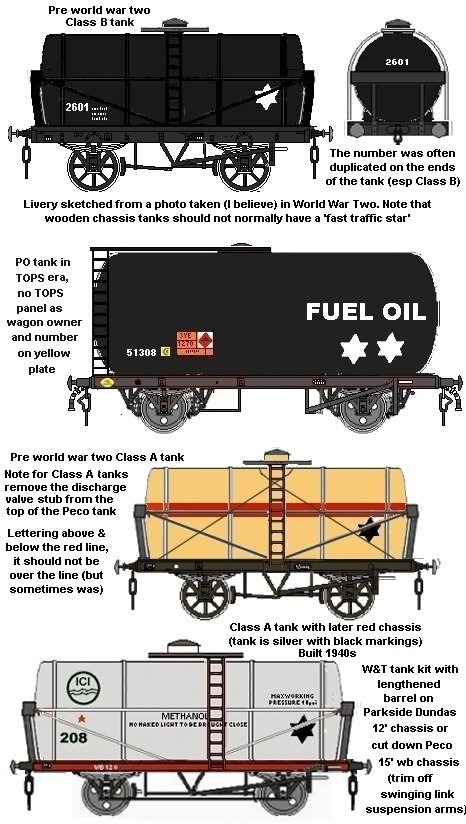
| Return to index page |
Tank Wagon Liveries
NB The colours used were obtained by sampling colour pictures, they may however vary from the true colour, use as a rough guide only
See also the section Goods Rolling Stock Design - Rail Tanks for
additional liveries
Note the illustrations and livery notes on petroleum oil and tar tanks have been moved to the lineside Industries section under 'Petroleum and LPG', 'Lubricating Oils' and 'Coal Tar and Wood Tar Distillers'
Most tank wagons have always been privately owned. Chassis are usually black (but see Class A tanks below) and early tank wagon barrels were usually painted red, grey or black (the red varied from red-brown to pillar box red and the grey varied a lot) with white lettering. A less common colour was 'stone' (similar to Humbrol 'Light Earth') which could be lettered in either white or red. It is worth noting that tank numbers were often applied to the ends of the tank, where they were less likely to be obliterated or dissolved by spillage's from the filling dome. Markings on tank wagons are often offset to either end of the tank barrel for the same reason.
Fire was always a concern for the railways, who established three basic divisions for liquids based on their flashpoint. Class A were special tanks in a special livery for liquids with flash points below 73 deg. F. (23 deg. C.), Class B were also special tanks with distinctive livery for liquids with flash points falling between 73 deg F and 141 deg. F. (60 deg C), and (with one or two exceptions) anything that has a higher flashpoint is not constrained.
Any tank wagon carrying petrol (gasoline). benzene, benzol, benzolene, lythene, naphtha, toluol butyl acetate, carbon disulphide, ether, ethyl acetate, nickel carbonyl, acetone, ethyl alcohol, methyl alcohol, methylated spirit, propyl alcohol and pyridine or marked 'motor spirit' would be in Class A livery.
Class B wagons are certified for use with Paraffin (kerosene), mineral oil, shale oil, turpentine, white spirit and coal tar (along with amyl acetate, amyl alcohol, butyl acetate (non iso), butyl alcohol, ethyl lactate).
Bitumen, heavy fuel oil and lubricating oils have high flashpoints but on the railways they are usually transported in Class B wagons. These unclassified liquids are not required to follow any particular colour scheme but the majority seem to have used the standard Class B colours of red oxide or black.
Some liquids can vary depending on how they were made, hence they may fall into any of the three groups. These include paints (bituminous or otherwise) photograuve printing inks, floor furniture and metal polishes, cellulose enamels and lacquers (these last two usually have alcohol in them).
The RCH official livery for volatile Class A liquid tanks, such as
petroleum, was from 1907 to 1939, a stone body colour with a red band extending
right round the body about half way up the tank about 6 inches (15 cm) wide.
The band around the tank was supposed to be applied over the company logo, or the livery would
be applied to either side, above and below the line. In some cases the livery
was applied over the line however. The solebars were to be painted red with black running gear (the red chassis was required for all dangerous cargo but does not seem to have applied to gunpowder vans).
In 1939 the rules were relaxed slightly, the
red stripe extending only part way along the sides of the tank (typically a quarter of the
way from each end of the tank), and aluminium was permitted as the body colour.
This was rescinded during the war due to the danger of enemy air attack and a
uniform matt dark grey tank with black chassis was adopted (some tanks were painted in camouflage of
two shades of grey).
After the war the aluminium was again permitted for Class
A tanks and the red band on the tank was not reinstated but solebars were again supposed to be red (this seems to have taken a while to appear however). On the large bogie 'frameless' tankers the red paint
is confined to the short sub-chassis above the bogies. Class A wagons do not
have heavy black staining to the body, petrol is pretty clean stuff in the main
but as with all rolling stock they do get stained and dirty in use.
For less volatile Class B liquids, heavy oils and tars, the 1907 specification was red oxide, this was a pretty lax specification and colours used varied from pillar box red to a light muddy brown similar to old rust. Where the wagons were used for tar and other liquids falling outside the Class A and B specifications I am told that the most common colour was red oxide, followed by grey with black as the third most popular option. I would suspect for tar wagons black would be a likely choice.
The large six pointed star seen on tank wagons was introduced in 1913, and indicated the wagon was suitable for fast traffic (that is for trains with average speeds of 35 miles per hour and stops at intervals of no more than 40 miles). It was sometimes, rather optimistically and incorrectly, applied to some very old wagons such as a rectangular tank wagons on wooden chassis with a nine foot wheelbase, however this may have been simply for the purposes of publicity photographs. The star was 2 feet across and either black (on white or yellow tanks) or white. There were also two star wagons, authorised to run at higher speeds, and three star wagons, which could run in a passenger train (the use of non bogie stock in passenger trains was banned in the later 1950s). A sketch of a three starred beer tank wagon can be seen in the section 'Goods rolling stock design - Tank wagons'
Fig___ Examples of Class A and Class B tank wagon
liveries

Changes in policy during the 1960's produced a number of companies owning tank wagons which were hired out to the oil companies as required. In about 1974 logo's were removed from the wagons, although I have seen a photograph of a BP tanker bearing a small stick-on BP shield pasted above the data and warning panels at the left hand end of the tank in November 1984.
The introduction of TOPS meant that all vehicles had to have their owner identified (rather than just the firm using the vehicle), a small yellow plate was therefore added to the left hand end of the solebar to identify the owning company and the individual wagon number. These plates were all in place by 1970 but the older wagon numbers remained painted on the sides of the tanks, for example United Molasses owned their tanks and had numbers prefixed UM but they still had the yellow TOPS plate on the chassis. The `Hazchem' warning panels were first introduced on British Rail in the mid 1970's (about 1975 or 76 I believe), and these days they provide a welcome splash of colour to the lower left of the tank body or (less commonly) painted on a plate fitted to the chassis.
Fig ___ Hazchem symbols used on railway tankers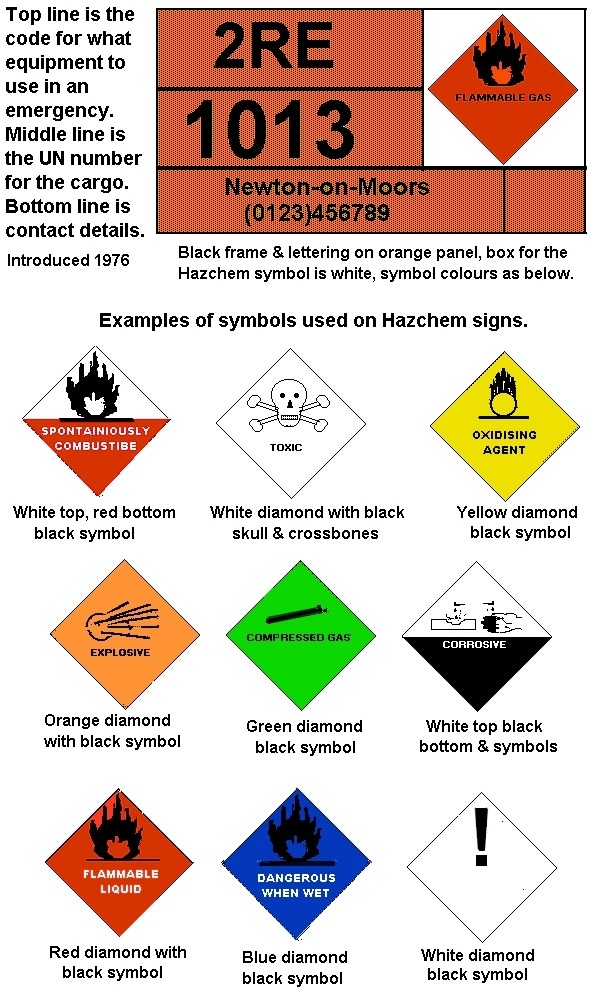
The new edition of the highway code may contain
coloured illustrations of the standard Hazchem symbols. The numbers and letters
in the upper box give the emergency services vital information on what
equipment is required to deal with a leak or fire. 1 means a water jet can be
used, 2 means a water 'fog' can be used, 3 means foam should be used and 4
means a dry powder fire extinguisher should be used. There are usually two
letters, the first tells you if you need to wear protective equipment, the
second tells you what you need to do to deal with a leak (dilute it or contain
it), the combination also tells you whether a 'violent reaction' is a possible
hazard. The letters used are P, R, S, T, W, X, Y and Z. The number in the
middle box in the 'United Nations' official number for the chemical being
carried. The bottom box is the emergency contact name and telephone number and
in the small box beside it appears the contact company name. Examples of
Hazchem data of interest to model makers include: 2PE/1073 oxygen 2PE/1005
ammonia, 2RE/1013 carbon dioxide, 2PE/1230 methanol, 2P/2789 acetic acid,
3R/1802 phosphoric acid, 2R/1798 hydrochloric acid. Although bitumen is
normally solid in transit it is flammable and when carried by road it is
required to display 2W/7033.
After about 1974 cleaning of oil tank wagons was generally discontinued, so Class B tanks often have heavy dark staining on their sides round the filling domes and the class A tanks have lighter coloured stains streaking their bodies in the same areas.
Pressurised gas tank wagons first appeared in the 1950's and have been
built on both bogie and four wheeled chassis. Large tank wagons for carrying ammonia,
nitrogen, oxygen, chlorine and carbon dioxide, appeared in the 1960's. These
tanks, and chemical tankers carrying volatile liquids which give off a vapour
such as hydro cyanic acid (HCN), all have a white or very light grey body.
The original 1950s markings included yellow and red stripes on the lower sides with a red rectangle with yellow centre wrapped round the corners at each end. These tanks received a sun shield in 1952 and by the mid 1950s the rectangular ferry plate was in use on the left hand end of the solebars (see also the Kitbashing section).
Fig___ Original pressurised gas tank livery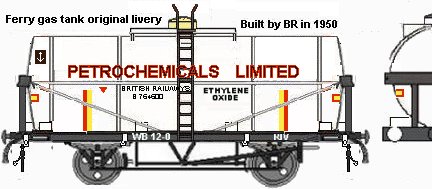
By 1960 this had changed to a white tank with a vertical red stripe painted round each end of the tank (as on my models). The ICI tanks shows were used for chlorine traffic, these unfitted tanks had a long working life, the 10'6" wheelbase chassis tanks were introduced in the 1940s and were finally withdrawn in about 1980.
This changed again (I believe) in the late 1960's, possibly as late as the very early
1970's, to a white tank with a horizontal orange stripe running right round the body to indicate the
contents are carried under pressure. Where the material carried was a 'Class A'
substance (such as liquefied petroleum gas) the solebars of the tank are
painted red.
Fig___ Pressurised gas tanks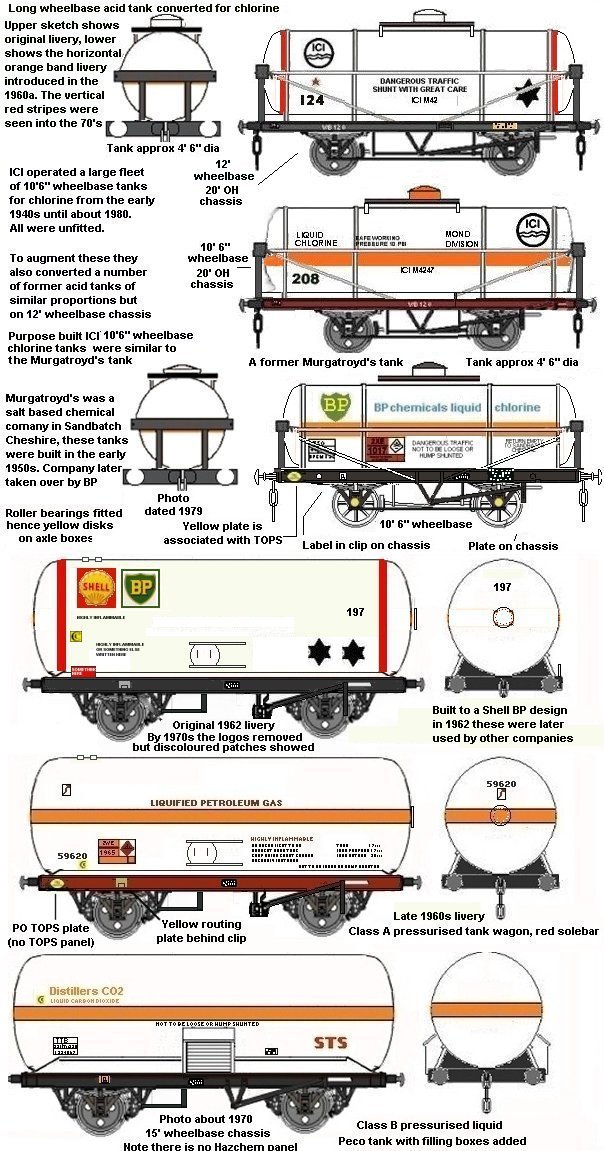
The Peco LPG tank kit (KNR P50) can be back-dated to the original 1962 Shell BP design by adding the side loading hatches, a 4mm diameter access hatch on one end, a 1mm diameter plate on the centre of the other end and a couple of pressure relief valves on top at one end. The basic livery was originally as shown below, by the later 1960s the shell and BP logos had been removed and these tanks were in use by other firms. The model shown below is for a layout set in the later 1960s and hence does not require the logos on the tank sides.
Fig___ Model of pressurised gas tank
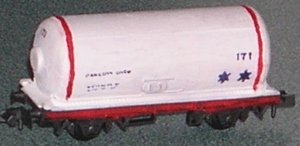
The Peco gas tank and the simple W&T tank wagon kit, producing a lagged (smooth sided) tank to fit a standard Peco chassis, can be liveried with a wrapper prepared on a table beforehand.
Molasses are used for a range of products, industrial ethyl-alcohol is made by fermenting the stuff then distilling the result. This then gets something nasty such as wood naphtha or pyridine added to try and stop people drinking it (pure alcohol is extremely poisonous), in the case of methylated spirit a violet dye is also added.
Fig ___ Molasses tank wagons 
Pure alcohol is in turn used to make acetone (nail varnish remover), acetaldehyde (a nasty but important chemical), acetic acid (the industrial form of vinegar) and more recently ethylene gas. Alcohol may be shipped out in railway tank wagons where it is classed as a Class A liquid.
One point to note is that the Class A tanks were not allowed to use gravity discharge via a bottom valve after 1905, this was banned following a spillage and fire. Hence if looking at Peco ten foot wheelbase tanks you have to carve off the small stub on the tank top beside the filling dome when using these for Class A traffic such as petrol. This stub is a square section post leading down inside the wagon to a valve at the bottom. The hand-wheel was not fitted (to avoid some idiot opening the valve in transit), instead the hand wheels were held at the discharge points for use by local staff. Bottom discharge of volatile liquids was again allowed from the later 1960s.
The W&T twin tank wagon kit, sold as a gas tank wagon, resembles a type which was used by a Scottish firm for oil traffic, however this livery would be very difficult to apply from individual lettering. With a little tinkering this kit makes a reasonable gas tank wagon for the GWR, LMS or LNER (see Fig ___).
The Vitriol tank kit supplied by Fleetline, is an example of a British Railways 10 ton (load) de-mountable tank used for acid. The chassis was painted in standard company or British Railways style and the tank was often in the livery of the leasing firm, if not it was either red or black with the product carried listed on the side as shown below.
If one uses the tubes and filling domes of the twin gas tank kit with the frames and wagons of two Vitriol tanks one ends up with a pair of de-mountable tanks, carried one per wagon, resembling those used for the shipment of tetraethyl lead, usually just called ethyl lead, to oil refineries for adding to petrol. Tetraethyl lead was the most widely used anti-knock agent in petrol up to the 1980's since when it has been replaced by methyl tert-butyl ether (MTBE) or mixtures of methanol and tert-butyl alcohol. The tank itself was a silver 'bare metal' colour when built (early 1950's) but was soon stained to a dull grey and streaked with darker shades in traffic. The chassis was black with fast traffic stars.
Fig ___ Demountable chemical tank wagon liveries
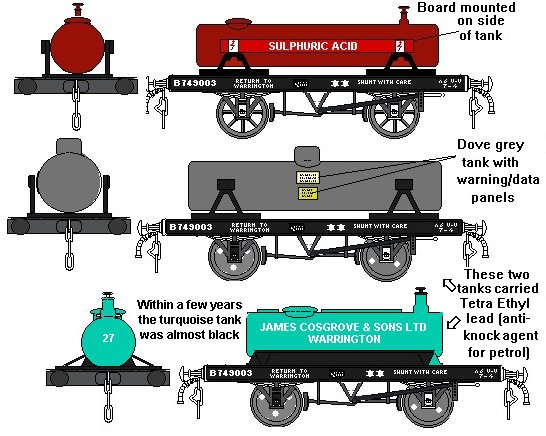
Fig ___ Chemical tank liveries 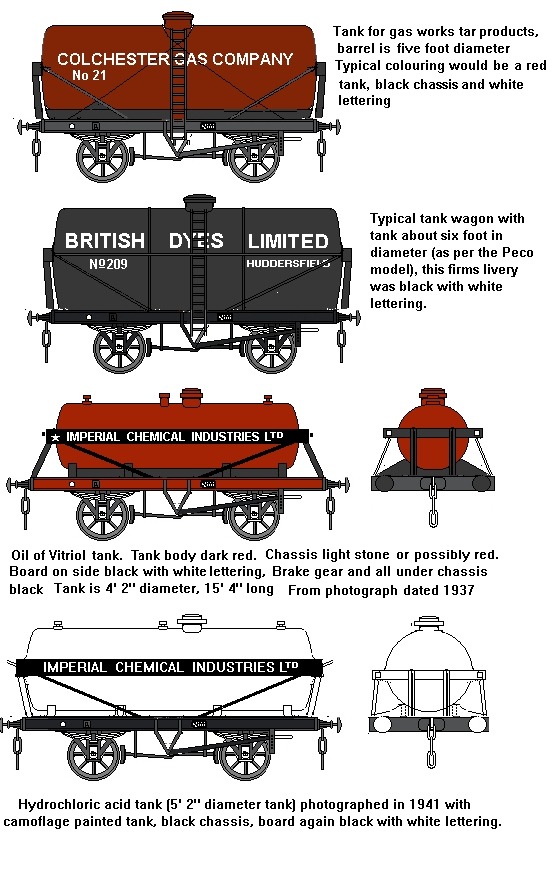
The number of available tank liveries has increased dramatically since this document was originally written, at which time I simply listed the available models and dated their liveries. Given the subsequent trend for releasing models in new liveries a better approach is no longer viable. Milk tank liveries are discussed in the section Freight Operations - Non Passenger Coaching Stock - Milk. More detail on the history of the petroleum oil, lubricating oil and tar distilling companies including some notes on liveries used has been added to the section on Lineside Industries under 'Petroleum and LPG', 'Lubricating Oils & Associated Works' and 'Coal Tar and Wood Tar Distillers'. Oil company logos are also described in Appendix One - Garages and Petrol Stations
Other users of tank wagons were firms shipping as fish and vegetable oils, regarding which see 'Lineside Industries - Industries associated with docks'.
Some of the liquids carried were very heavy, however I have seen very few examples of a non-milk six wheeled tanks. One of these had a black tank with white lettering, CABLE COMPOUND about a foot high on the sides (built for Scottish Cables Ltd, who were taken over by British Insulated Callendars Cables some time before the mid 1970s), an alternative livery, also from a photograph is shown below.
Fig ___ 6 wheeled cable compound tank 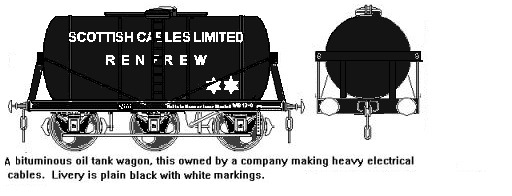
Another six wheeler was owned by Corn Products Limited, marked 'Corn Products Co Ltd' with underneath this written 'Globe 3A Health Glucose' and under that the number 37. I believe Lima offered an OO model, this was their milk tank in Corn Products livery (which would look about right).
This wagon, built in 1937, had the very rare 'three star' marking, indicating it could travel attached to fast passenger trains. Corn products Ltd was set up in 1903, it was owned by an American organisation who wished to import US produced maize starch products (either as syrup or as dry powders) into the UK for adding to foods. In 1924 they began manufacturing in Britain and in 1935 they acquired Brown and Poulson Ltd (one of the few remaining UK suppliers). They changed their name in 1950 to Brown and Poulson Ltd. At this time the UK was producing nearly 50 percent of its requirements, the rest being supplied by a large company called Tunnel Refining who imported from Belgium, several smaller firms and the imports of Corn Products Ltd. from the US and elsewhere. Corn Products Ltd. were still operating in the later 1970s, and were still being referred to as Corn Products Limited, but they had a number of operating arms, dealing with separate areas such as industrial, brewing, food etc) each of which used a different company name. In the 1970s they had several depots including; Trafford Park (Manchester - built after the second world war), Derby, Shardlow, London (Hackney) and Paisley. I believe they were only using hired tank wagons at that time.
There was a model of a 6 wheeled tank (originally sold as a milk tank) produced in OO with a black tank but with MOLASSES about 18 inches (46 cm) high on the side. I am not sure if this was based on a genuine prototype but it might well have been (United Molasses have long been regular users of rail transport). United Molasses started out as Marquis in Liverpool, the name changed to United Molasses in 1925 when the company headquarters moved to London, at this time they had bulk storage facilities in Hull for the imported product (at the time mainly used as an animal feed). UM were bought by Tate and Lyle in 1963 but the brand remained in use on railway wagons into the early 1970s.
The railway companies themselves used several designs of tank wagon, ranging from creosote tankers supplying depots producing sleepers, to gas cylinder tanks used for delivering gas to outlying stations, refilling coaching stock lighting tanks and supplying kitchen coaches. The liveries were a mixed bag and rather than try and explain them in the text I have included sketches of examples in 'Goods Rolling Stock Design - Departmental Stock'.